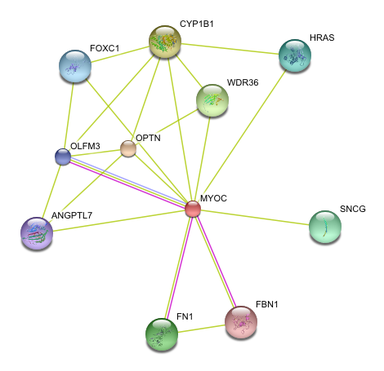This web page was produced as an assignment for Genetics 677, an undergraduate course at UW-Madison.
LOCATE listed no experimental or data literature for localization of the myocilin protein. However, UniProt recognizes that it is a secreted protein that localizes to the rough endoplasmic reticulum as well as in the basal body of the connecting cilium of photoreceptor cells.
SMART recognized the various proteins with which MYOC interacts. Below is a diagram of these interactions.
Analysis: Above is a map of the protein interactions for myocilin generated by SMART. This map shows myocilin's predicted functional partners: OPTN, CYP1B1, WDR36, FN1, SNCG, HRAS, FOXC1, OLFM3, ANGPTL7, and FBN1. The STRINGdatabase indicates it has the strongest associations with WDR36, OPTN, and CYP1B1. The strong association between myocilin, WDR36 and OPTN is especially important to note as these are the three genes/proteins whose mutations have been shown to correlate with glaucoma. Literature gives evidence for all protein interactions myocilin has with other proteins, however, only FN1, FNB1, and OLFM3 are the only proteins for which experimental data is known for confirming their associations according to STRING.
_______________________________________________________________________________________________
References:
1. Fuse, Nobuo. "Genetic Bases for Glaucoma." The Tohoku Journal of Experimental Medicine 221 (2010): 1-10. PubMed. Web. 22 Jan. 2011
http://www.jstage.jst.go.jp/article/tjem/221/1/1/_pdf
2. Rao, Kollu N., Srujana Nagireddy, and Subhabrata Chakrabarti. "Complex Genetic Mechanisms in Glaucoma: An Overview." Indian Journal of Opthamology 59.7 (2011): 31-42. PubMed. Web. 22 Jan. 2011.
http://www.ijo.in/article.asp?issn=0301-4738;year=2011;volume=59;issue=7;spage=31;epage=42;aulast=Rao
3. American Optometric Association. Answers To Your Questions About Glaucoma. St. Louis: American Optometric Association. Print.
4. http://www.forbes.com/2009/06/26/life-saving-devices-technology-personal-monitors_slide_7.html
5. http://www.youtube.com/watch?v=OJMEfGFbFMI
6. "MYOC - Myocilin, Trabecular Meshwork Inducible Glucocorticoid Response - Genetics Home Reference." Genetics Home Reference - Your Guide to Understanding Genetic Conditions. 6 Feb. 2011. Web. 08 Feb. 2011. http://ghr.nlm.nih.gov/gene/MYOC
7. Saura, Maria, Montse Cabana, Carmen Ayuso, and Diana Valverde. "European Journal of Human Genetics - Mutations including the Promoter Region of Myocilin//TIGR Gene." Nature Publishing Group : Science Journals, Jobs, and Information. 13 Oct. 2004. Web. 08 Feb. 2011. http://www.nature.com/ejhg/journal/v13/n3/full/5201299a.html
8. Fingert, John H., Elise Heon, Jefferey M. Liebmann, Tetsuya Yamamoto, Jaime E. Craig, Julian Rait, Kazuhide Kawase, Sek-Tien Hoh, Yvonne M. Buys, Joanne Dickinson, Robin R. Hockey, Donna Williams-Lyn, Graham Trope, Yoshiaki Kitazawa, Robert Ritch, David A. Mackey, Wallace L.M. Alward, Val C. Sheffield, and Edwin M. Stoned. "Analysis of Myocilin Mutations in 1703 Glaucoma Patients From Five Different Populations — Hum Mol Genet." Oxford Journals | Life Sciences & Medicine | Human Molecular Genetics. 14 Mar. 1999. Web. 08 Feb. 2011. http://hmg.oxfordjournals.org/content/8/5/899.full
9. McMahon, C., Semina, E.V., Link, B.A. "Using zebrafish to study the complex genetics of glaucoma." Comparative Biochemistry and Physiology Part C: Toxicology and Parmacology. vol 138-3. July 2004. Web. 24 Feb 2011. http://www.sciencedirect.com/science?_ob=ArticleURL&_udi=B6W89-4CDJG6X-1&_user=443835&_coverDate=07%2F31%2F2004&_rdoc=1&_fmt=high&_orig=search&_origin=search&_sort=d&_docanchor=&view=c&_acct=C000020958&_version=1&_urlVersion=0&_userid=443835&md5=525db1a96bf7be7620dabbcd34c426f9&search#toc2
10. Kubota, R., Noda, S., Wang, Y., Minoshima, S., Asakawa, S., Kudoh, J., Mashima, Y., Oguchi, Y., Shimizu, N. "A novel myosin-like protein (myocilin) expressed in the connecting cilium of the photoreceptor: molecular cloning, tissue expression, and chromosomal mapping." Genomics. vol 41-3.1 May 1997, Pages 360-369 Department of Molecular Biology, Keio University School of Medicine, Tokyo, Japan. http://www.sciencedirect.com.ezproxy.library.wisc.edu/science?_ob=ArticleURL&_udi=B6WG1-45M8YTG-C5&_user=443835&_coverDate=05%2F01%2F1997&_rdoc=1&_fmt=high&_orig=gateway&_origin=gateway&_sort=d&_docanchor=&view=c&_acct=C000020958&_version=1&_urlVersion=0&_userid=443835&md5=1562ae0f98031b9d89c1c8377a859b1e&search
References:
1. Fuse, Nobuo. "Genetic Bases for Glaucoma." The Tohoku Journal of Experimental Medicine 221 (2010): 1-10. PubMed. Web. 22 Jan. 2011
http://www.jstage.jst.go.jp/article/tjem/221/1/1/_pdf
2. Rao, Kollu N., Srujana Nagireddy, and Subhabrata Chakrabarti. "Complex Genetic Mechanisms in Glaucoma: An Overview." Indian Journal of Opthamology 59.7 (2011): 31-42. PubMed. Web. 22 Jan. 2011.
http://www.ijo.in/article.asp?issn=0301-4738;year=2011;volume=59;issue=7;spage=31;epage=42;aulast=Rao
3. American Optometric Association. Answers To Your Questions About Glaucoma. St. Louis: American Optometric Association. Print.
4. http://www.forbes.com/2009/06/26/life-saving-devices-technology-personal-monitors_slide_7.html
5. http://www.youtube.com/watch?v=OJMEfGFbFMI
6. "MYOC - Myocilin, Trabecular Meshwork Inducible Glucocorticoid Response - Genetics Home Reference." Genetics Home Reference - Your Guide to Understanding Genetic Conditions. 6 Feb. 2011. Web. 08 Feb. 2011. http://ghr.nlm.nih.gov/gene/MYOC
7. Saura, Maria, Montse Cabana, Carmen Ayuso, and Diana Valverde. "European Journal of Human Genetics - Mutations including the Promoter Region of Myocilin//TIGR Gene." Nature Publishing Group : Science Journals, Jobs, and Information. 13 Oct. 2004. Web. 08 Feb. 2011. http://www.nature.com/ejhg/journal/v13/n3/full/5201299a.html
8. Fingert, John H., Elise Heon, Jefferey M. Liebmann, Tetsuya Yamamoto, Jaime E. Craig, Julian Rait, Kazuhide Kawase, Sek-Tien Hoh, Yvonne M. Buys, Joanne Dickinson, Robin R. Hockey, Donna Williams-Lyn, Graham Trope, Yoshiaki Kitazawa, Robert Ritch, David A. Mackey, Wallace L.M. Alward, Val C. Sheffield, and Edwin M. Stoned. "Analysis of Myocilin Mutations in 1703 Glaucoma Patients From Five Different Populations — Hum Mol Genet." Oxford Journals | Life Sciences & Medicine | Human Molecular Genetics. 14 Mar. 1999. Web. 08 Feb. 2011. http://hmg.oxfordjournals.org/content/8/5/899.full
9. McMahon, C., Semina, E.V., Link, B.A. "Using zebrafish to study the complex genetics of glaucoma." Comparative Biochemistry and Physiology Part C: Toxicology and Parmacology. vol 138-3. July 2004. Web. 24 Feb 2011. http://www.sciencedirect.com/science?_ob=ArticleURL&_udi=B6W89-4CDJG6X-1&_user=443835&_coverDate=07%2F31%2F2004&_rdoc=1&_fmt=high&_orig=search&_origin=search&_sort=d&_docanchor=&view=c&_acct=C000020958&_version=1&_urlVersion=0&_userid=443835&md5=525db1a96bf7be7620dabbcd34c426f9&search#toc2
10. Kubota, R., Noda, S., Wang, Y., Minoshima, S., Asakawa, S., Kudoh, J., Mashima, Y., Oguchi, Y., Shimizu, N. "A novel myosin-like protein (myocilin) expressed in the connecting cilium of the photoreceptor: molecular cloning, tissue expression, and chromosomal mapping." Genomics. vol 41-3.1 May 1997, Pages 360-369 Department of Molecular Biology, Keio University School of Medicine, Tokyo, Japan. http://www.sciencedirect.com.ezproxy.library.wisc.edu/science?_ob=ArticleURL&_udi=B6WG1-45M8YTG-C5&_user=443835&_coverDate=05%2F01%2F1997&_rdoc=1&_fmt=high&_orig=gateway&_origin=gateway&_sort=d&_docanchor=&view=c&_acct=C000020958&_version=1&_urlVersion=0&_userid=443835&md5=1562ae0f98031b9d89c1c8377a859b1e&search




